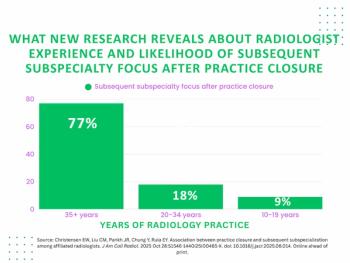
Considering more staff? Evaluate contracts first
Is it time to add another physician? We have asked this question quite a bit recently, especially on busy days, which seem to be happening more often. Because adding another full-time physician would be expensive-especially if we guessed wrong-we wanted to make sure that it really was time to expand.
Is it time to add another physician? We have asked this question quite a bit recently, especially on busy days, which seem to be happening more often. Because adding another full-time physician would be expensive-especially if we guessed wrong-we wanted to make sure that it really was time to expand.
Judging from how many studies we were reading per shift and per radiologist, it seemed that the workload could justify another physician. Looking at this work in more detail however, we quickly realized that not all of it was of equal value to us.
Our group has multiple lines of business; some are hospital-based and some are direct contract or teleradiology. Only a careful look at all of our contracts would help us figure out if we might be better off deleting some of that business instead of adding a physician to help handle it. Here’s what we looked at and what we found in our review:
- Per-exam reimbursement and cost trending. We looked at reimbursement vs. cost per exam over the last several years in each business line. We found some lines of business were trending down in per-exam reimbursement while others were trending up.
- Payment terms. In the current environment, we gave strong preference to flat-rate contracts. We also looked at whether those rates were still competitive.
- Payment performance. We viewed flat-rate contracts with lower-than-desired rates as favorable over those with higher rates that also had greater proportions of nonpayment.
- Additional benefits. We also considered whether the various lines of business in which we were involved provided other benefits, such as promoting relationships with physicians who refer patients to our hospital system for MRIs but also own their own CTs, which we read.
- Potential. We looked at which lines of business could be grown and which were in the best alignment with our long-term goals, such as a new contract that will lead to more business from the same source; or a contract with a provider that works with an underserved population.
- Fit. From a financial standpoint, we looked at the type of exams we were reading for our various contracts to see how each matched up with our staffing specialties.
- Costs. Some contracts put more costs on our back office, such as requiring more administrative effort to bill and collect, or requiring multiple calls to IT staff for technical problems.
- Impact. All lines of business come at a cost, so we considered such intangible costs as the impact some of the business lines had on our lifestyles in terms of daytime versus nighttime service, amount of weekend service, or volume of stat calls. In other words, we looked at each contract in terms of how labor-intensive it was for the radiologists.
Lastly, we looked at qualitative issues related to each contract. For example, we considered it a negative if the partner we contracted with called us often or made excessive demands.
In the end we kept all of our current contracts, but we gained a lot of insight into how we will approach each line of business in future negotiations. Contracts can be great, but if the business they bring has a high labor cost or substantial lifestyle impact, or if they send work that does not match your staffing, are with a low-paying partner, raise back-office expenses, have no potential to grow, and do not link you to referring MDs with whom you have a relationship, then what is the true value of that agreement? You may want to eliminate that business and the stress it is causing you instead of hiring a new full-time MD and dealing with the potential financial stress and uncertainty of an ill-timed hire.
Dr. Woodcock is medical director for MRI at St. Joseph’s Hospital in Atlanta. He is also a member of the executive board of Atlanta Radiology Consultants and is the practice’s executive officer for finance. He may be reached at rjwatlrad@gmail.com .
Newsletter
Stay at the forefront of radiology with the Diagnostic Imaging newsletter, delivering the latest news, clinical insights, and imaging advancements for today’s radiologists.






























